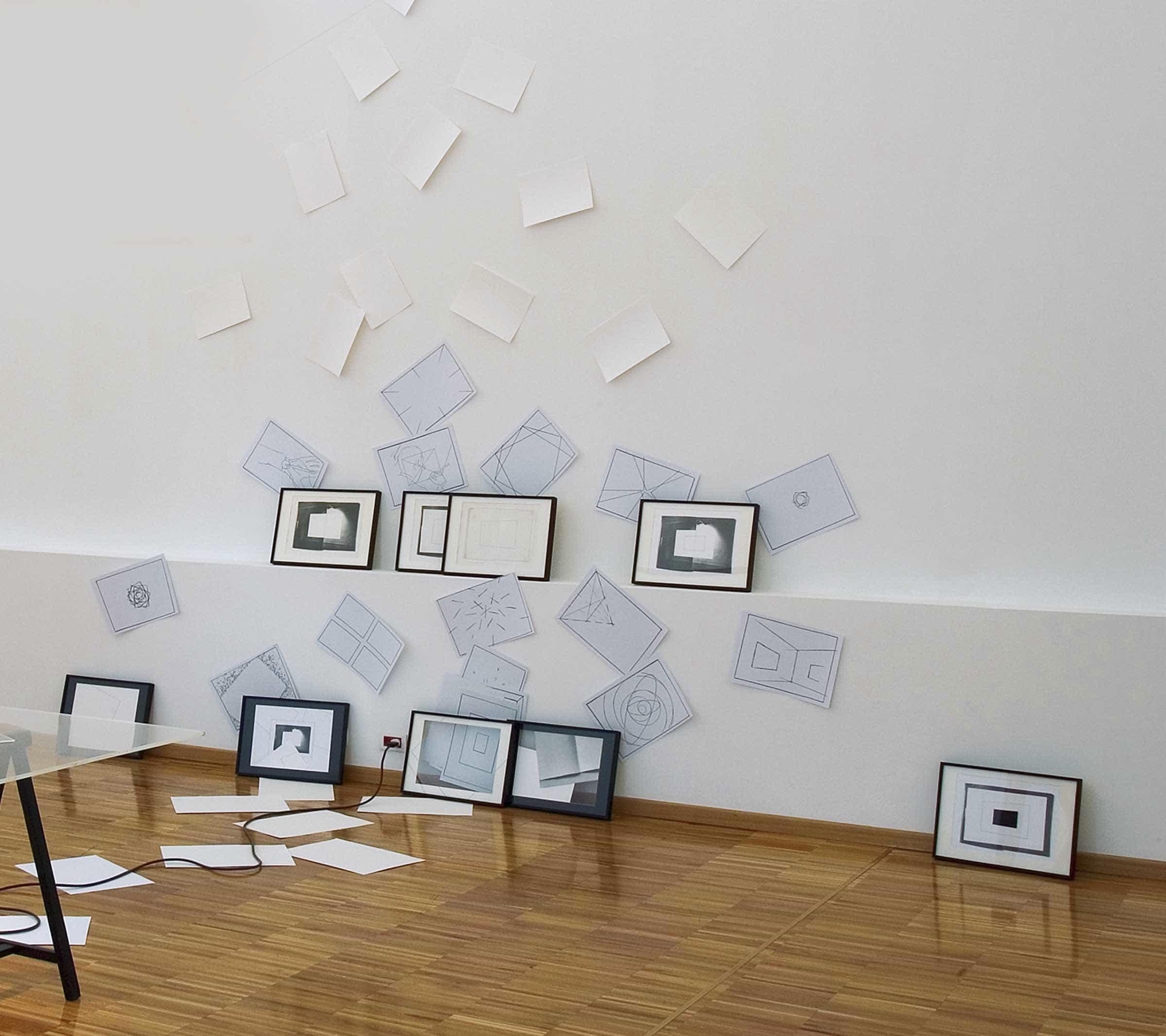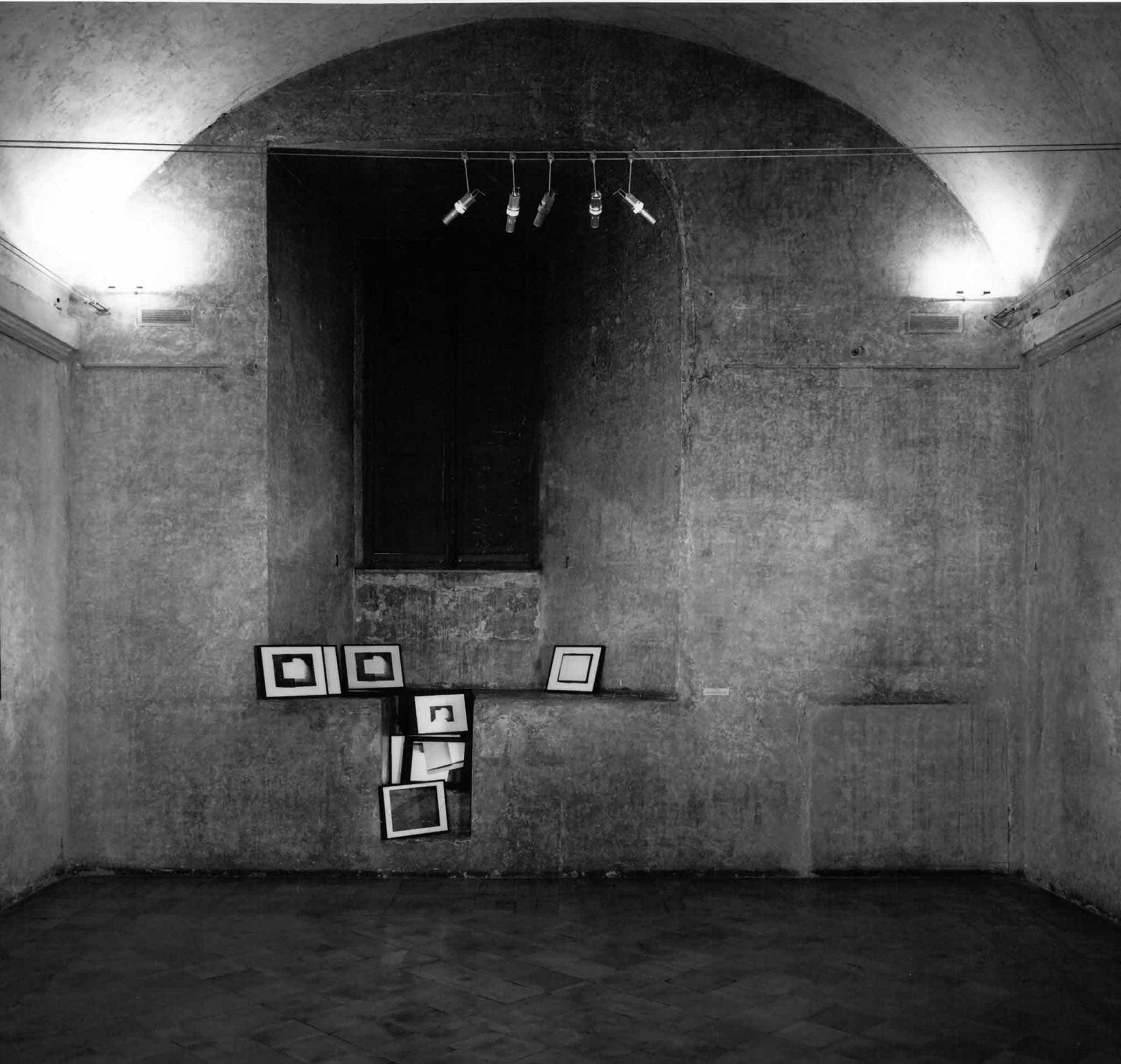Cahiers d’art, 1994
GPO-0742
Pencil and collage on photo print and on paper
Nine framed parts 35.5 x 50 cm each, overall dimensions variable
Collection of the artist
The installation varies depending on the situation that is available. The only premise is the placement of the framed elements at several levels, including the floor (some are on a shelf, others on a wall, still others on the floor). The dissemination of the paper elements depends on the display situation; in a smaller spatial context, they can even be omitted.
• 1996, Rome, Villa Medici: the nine elements are arranged at random in a T-shaped niche, with several elements propped up against the horizontal plane and others inserted in the median niche, as if they were falling freely.
• 2006, Bergamo, GAMeC: the nine elements – arranged in part on a plane that protrudes just slightly from the wall, and in part on the ground – are integrated with sixteen drawings (planetary orbits, the image of a hand drawing, vanishing points, ensembles of squares, etc.) scattered around the frames, as well as a "fall" of blank sheets from the top of the wall all the way to the ground.
The nine framed elements feature different iconographic variations on the motif of the blank sheet, as if they were the pages of a drawing album or a notebook, evoked by the French expression in the title.
Five elements feature a blank square on a variable background,1 at times with a drawing of other squares made on the passepartout; a sixth element features a black square in the centre. The remaining three elements feature the following, respectively: an empty white passepartout with a drawing of tilted squares; a black passepartout with a blank sheet featuring a pencil drawing that alludes to a sheet in a tilted position; a black passepartout from which the printed image of a blank sheet that was previously folded is visible.2
The installation of the nine framed elements, which vary depending on the exhibition, calls for the arrangement of the components at different levels, including the floor, eventually integrated with other drawings and/or blank sheets.
1 This is the basic iconography of the three plates of the print edition Cahiers d’art made in 1974 (GPE-0014), cat. no. 14, which include the following: 1) a blank sheet applied to the centre of the photograph of an open book reproducing an exhibition space, as it if were a painting hanging on the wall; 2) a larger blank sheet, which almost entirely covers the image of the book and features at the centre a square drawn in pencil; 3) a blank sheet that hides the entire photograph and presents, in the form of a drawing, the situation of the first plate. The image from the book reproduces the double-page spread of the exhibition catalogue Teatro delle mostre (Rome: Lerici Editore, 1968), with the exhibition view of Paolini's work on display at that event. The title refers to the name of the Paris magazine founded in 1926 by Christian Zervos, as well as to the homonymous publishing house, known for its many monographic texts on modern French artists.
2 It is a detail from the print edition Œuvres complètes, 1993 (GPE-0093).
Title from the Parisian magazine founded by Christian Zervos in 1926, and from the eponymous publishing house.
| 1996 | Rome, French Academy, Villa Medici, Giulio Paolini. Correspondances, 13 March - 28 April, cat. no. 5, not repr. |
| 2006 | Bergamo, Accademia di Belle Arti, Giulio Paolini. Fuori programma, 6 April - 16 July, col. repr. pp. 108-109, 111 (exhibition views), referred to in the text by E. Grazioli pp. 23-24. |
| • | M. Disch, Giulio Paolini. Catalogo ragionato 1960-1999, vol. 2 (Milan: Skira editore, 2008), cat. no. 742 p. 756, col. repr. (exhibition view Bergamo 2006). |



